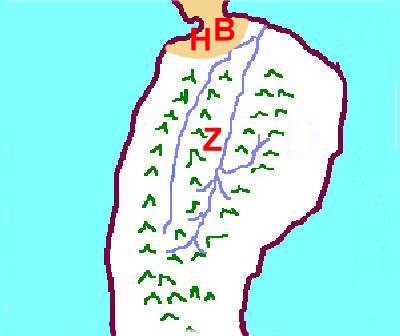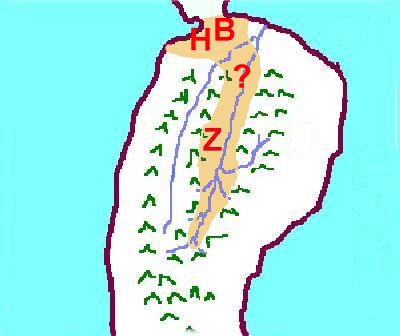
As pointed out in the previous stage, the northern realms of the wilderness of Hermounts which reached into Bountiful became cleared due to the cutting and harvesting of the timber to be shipped to the land northward (Helaman 3:9-11). Not only had much of the population migrated north by land and sea into the land northward, but in Zarahela itself, there had been a dynamic population shift. Once nothing but wilderness (Alma 22:31), Bountiful had become a population center due to Hagoth's ship building the the subsequent shipping industry which most likely was not only used to ship timber north, but the enterprising ship masters would asuredly bring trade goods back also. Bountiful had become the new ecomonic center of the nation of Zarahemla, and though the majority of the population was still most likely contained in the nation's central Zarahemla valley, the economic crossroads had shifted north.

Lamanite Invasion. Beginning in 38 BC, there began to be dissensions and contentions amoungst the Nephites to the point of much blood shed, and the primary rebellious discenting faction left the land of Zarahemla and went over into the land of the Lamanites and joined with them stirring the Lamanites up to come against the Nephites of Zarahemla (Helaman 4:1-4). And by 34 BC the Lamanite armies had invaded the nation of Zarahemla taking possition of all the land even until they had driven the Nephites into the land which was next to the land of Bountiful. And from that land even unto the land of Bountiful. (Helaman 4:4-5) For illustrative purposes the rough map at the right shows relatively what the invasion of the Lamanites had reduced the nation of Zarahemla to at this point in time.
It seems quite appropriate at this juncture to stress two important points of consideration. First, the recored of Mormon is an abridgement, a condensation, an abbreviated history. As such many sites and cities have been left out of the picture that we have so far built of the nation of Zarahemla. And many students and readers of the Book have misjudged and vastly under estimated the size and distances of the land. Just how easy this is to do when working with an abridged record is quite well illustrated in Helaman chapter 4. The abridge account there merely states that the Lamanites where successful in obtaining possession of the land of Zarahemla even unto the land near Bountiful and then even unto Bountiful. Now Mormon has not supplied us with a detailed map, may cities and lands are missing from such a map of Zarahemla. But that is making the same mistake that a casual reader may make currently in reading Helaman 4:4-5. He might assume from the shortness of the account that the land of Zarahemla did not consist of much, since in relatively short order, a year or two, the Lamanites had taken possession of all the lands of the nation of Zarahemla except Bountiful on the north which goes into the narrow neck to the line on which it borders the land of Desolation. Now hopefully, after having come to this point in this discussion of the colonization and settlement of the nation of Zarahemla, an appreciation that such a limited view is erroneous. We know of cities, lands, villages, plains and vast wildernesses all of which make up even Mormon's abridged map of the Nation of Zarahemla. There is Manti in the head waters of the Sidon, with the lands of Zeezoram, Cumeni, Antiparah, and the City by the Sea Shore with there wilderenesses inbetween. There is Judea, Melek which was large enough to accept the people of Ammon even after being highly populated, and Ammonihah, Noah, and Sidom. There is Minon and the vast lands of the Zarahemla valley with many cities and lands un-named in the 'capital parts of the land' (Helaman 1:27-28) from the city of Zarahemla down north along the Sidon valley and thence around and up to the province of Bountiful. There is the valley of Gideon and the city of Aaron. There was the land of Antionum and Jershon, and all the defensive cities of Nephihah, Moroni, Lehi, Morianton, Omner, Gid, and Mulek. And with all of these, there were many un-named and unlocated cities of the nation of Zarahemla. The Savior recites other cities of the destruction which had never been mentioned before, a number of which where amoung the cities of Zarahemla. So what's the point. The point is that we do not know all the lands and cities of the Nation of Zarahemla, or the land north or the land of Lehi-Nephi and of Nephi. In reading an abridgement, I would suggest that caution be taken not to limit and condense the land into being less that what it really is. So when the Book of Mormon in rather short order states that the Lamanite invasion pushed the Nephites of the nation of Zarahemla into that last extreme northern province of Bountiful, consider that it basically displaced an entire nation of people into just one of the many provinces of that nation, which provinces contained many cities, towns and lands within each of them. It might be likended to invading and pressing the whole of the United States up into the far reaches of perhaps one or a few of the northeastern states of the New England corner.
 Now a second point already stated, but which needs further emphasis is
that region where there were many cities and lands even between the local
land, city and province of Zarahemla, all the way down to the northern land
of the Sidon valley to the city of Bountiful which we have merely alluded to
with a '?' on all our previous maps. And as long as we are discussing the
size and vastness of the land, it is important to here point out that as well
for our understanding at this time relative to the discussion that will
follow. After the time of Captain Mormoni, Moronihah, Moroni's son became
Chief Captain of the Nephite army. A man named Coriantumr, a mighty man and a
discenter from Nephites was placed at the head of the Lamanite army in 50 BC.
Knowing the land and the wildernesses between the cities of the Nephites, he
was able to lead a supprise attack upon the center of the land, even the city
of Zarahemla. Moroihah had considered this to be such a military blunder that
the Lamanites would not even consider doing such, coming against the center
of the land and surrounding themselves by Nephites on every side. But
Coriantumr did, and since Moronihah had not anticipated it, Coriantumr was
able to take the city of Zarahemla with relative ease. In fact it encouraged
Coriantumr to immediately continue his invasion and go directly for the
narrow neck of land, fighting his way through the central parts of the land
as he went. Again, without naming the enterviening cities and land, Mormon's
abridgement merely states that the Lamanites ". . . were marching through the
most capital parts of the land, slaying the people with a great slaughter,
both men, women, and children, taking possession of many cities and of many
strongholds." (Helaman 1:27) Now this does not completely define the question
mark on my maps above the 'Z' for Zarahemla. But it gives an abbreviated
indication that my map as I have built it has dealt only with the round about
fringes of the land, the military front or fontier if you will, becuase
Mormon says that the '?' area was 'The Most Capital Parts of the Land,' and
that it consisted of 'Many Cities' and 'Many Strongholds.' That is no small
'?' in my Book of Mormon. And it further stresses that we have but a small
portion of the sites, lands, cities, and general mapping of the national land
of Zarahemla. There is much more to the national land than what most readers,
students and even other Book of Mormon Geography mappers have ever considered
giving the nation of Zarahemla credit for being.
Now a second point already stated, but which needs further emphasis is
that region where there were many cities and lands even between the local
land, city and province of Zarahemla, all the way down to the northern land
of the Sidon valley to the city of Bountiful which we have merely alluded to
with a '?' on all our previous maps. And as long as we are discussing the
size and vastness of the land, it is important to here point out that as well
for our understanding at this time relative to the discussion that will
follow. After the time of Captain Mormoni, Moronihah, Moroni's son became
Chief Captain of the Nephite army. A man named Coriantumr, a mighty man and a
discenter from Nephites was placed at the head of the Lamanite army in 50 BC.
Knowing the land and the wildernesses between the cities of the Nephites, he
was able to lead a supprise attack upon the center of the land, even the city
of Zarahemla. Moroihah had considered this to be such a military blunder that
the Lamanites would not even consider doing such, coming against the center
of the land and surrounding themselves by Nephites on every side. But
Coriantumr did, and since Moronihah had not anticipated it, Coriantumr was
able to take the city of Zarahemla with relative ease. In fact it encouraged
Coriantumr to immediately continue his invasion and go directly for the
narrow neck of land, fighting his way through the central parts of the land
as he went. Again, without naming the enterviening cities and land, Mormon's
abridgement merely states that the Lamanites ". . . were marching through the
most capital parts of the land, slaying the people with a great slaughter,
both men, women, and children, taking possession of many cities and of many
strongholds." (Helaman 1:27) Now this does not completely define the question
mark on my maps above the 'Z' for Zarahemla. But it gives an abbreviated
indication that my map as I have built it has dealt only with the round about
fringes of the land, the military front or fontier if you will, becuase
Mormon says that the '?' area was 'The Most Capital Parts of the Land,' and
that it consisted of 'Many Cities' and 'Many Strongholds.' That is no small
'?' in my Book of Mormon. And it further stresses that we have but a small
portion of the sites, lands, cities, and general mapping of the national land
of Zarahemla. There is much more to the national land than what most readers,
students and even other Book of Mormon Geography mappers have ever considered
giving the nation of Zarahemla credit for being.